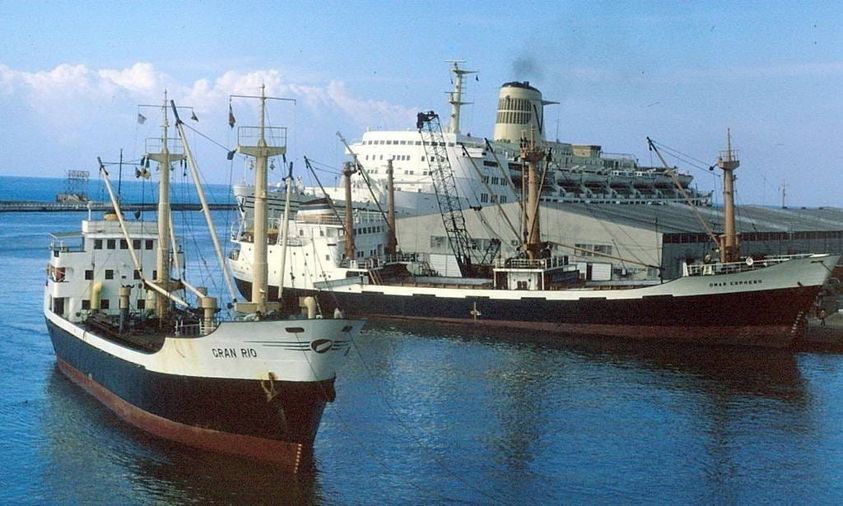 Screaming seagulls study snorkelers, beyond the low wall of pale pink boulders that protect the private beach lined with coconut trees and bright orange deck chairs. Flecked with algae-covered coral, the clear waters stretch in darkening depths of blue as far as the eye can see, offering panoramic views framed by potted palms and perfect columns.
Screaming seagulls study snorkelers, beyond the low wall of pale pink boulders that protect the private beach lined with coconut trees and bright orange deck chairs. Flecked with algae-covered coral, the clear waters stretch in darkening depths of blue as far as the eye can see, offering panoramic views framed by potted palms and perfect columns.
Back in November 1999, this entire prime piece of breezy Tobago shorefront looked very different. Battered by steady surges caused by Hurricane Lenny, the curving breakwater and all the precious sand at the posh Coco Reef Resort eroded, as the rough effects of the storm swung far south.
Nicknamed “Wrong Way Lenny,” the hurricane formed in the Caribbean Sea and maintained an unprecedented west-to-east track for its entire ten-day duration, briefly becoming a Category Four event, and leaving some US$786M in damage including to yachts anchored off Chaguaramas Bay, across in the mainland. Tobago is located 18 miles or 30 kilometres (km) northeast of Trinidad’s Toco tip, separated by a deep channel 23 miles or 37 km wide, famed as the Galleons Passage on antique charts.
Five months later, a small cargo vessel, the “Gran Rio R” sailed from Guyana with an order of 1, 500 tonnes of sparkling white silica sand destined for the popular holiday complex, in Crown Point, at the far end of the cigar-shaped island. The resort had been racing to rebuild its man-made beach, in preparation for the return of sun-seeking tourists from North America and Europe, even as the low end of the season approached.
In 1992, the Bermuda-based entrepreneur John Jefferis launched construction of the US$82M Coco Reef Resort, developing it into one of the Caribbean’s most successful properties. It caused British Airways to fly directly to Tobago, making the island a serious tourism destination. One English retiree who lives in France recalled his memorable stay at the hotel when “Hurricane Lenny wrecked the beach, beach restaurant, and water sports shop.”
On the routine trip that began without incident on April 9, 2000, the “Gran Rio R” group of nine men was supposed to return home within days. We know the ship did arrive at the main Port of Scarborough two days later. After checking in with the immigration authorities and being cleared, it left for the final leg of the journey that should have taken about 90 minutes.
But 21 years later, stunned families and friends are still grieving, waiting for answers that may never come, agonising over the ship that never arrived, and the victims’ fair treatment compensation that never materialised. The crew’s mysterious disappearance without a trace, off the south-western coast of Tobago that day, in the absence of an erratic hurricane or a hint of inclement weather, is a perplexing case that remains unsolved.
The Trinidad and Tobago (T&T) authorities started prolonged sea and air searches of the coastal areas the following day, Wednesday, on being informed at about 11 a.m. that the carrier had not reached Crown Point. Numerous conflicting news reports in the two neighbouring Caribbean countries, about who the crew of the “Gran Rio R” supposedly contacted, and the precise times, have contributed to lingering questions, despite appeals to the then Guyana President, Bharrat Jagdeo, and associated Ministers and officials for intervention and information.
Parties agree the “Gran Rio R” radioed it was taking on water and would require a standby pump when it docked at Crown Point. Accounts range from the crew of a sister company vessel around 5:25 p.m. to a late night weak alert four hours later, allegedly picked up by T&T’s Coastguard across in Staubles Bay, Chaguaramas by which time night had set in.
Elderly parents have passed on, their lonely quest for proof of their loved ones’ fate unfulfilled, in the absence of any confirmed wreckage such as wood from the hatches, fuel storage barrels or a tell-tale oil slick. Widows and relatives continue to mourn and wonder.
Others have remarried and tried to move on, following the customary presumption of death after being missing for seven years and more. Several migrated, and at least one took her young son, who would never know his easy-going American father from Des Moines, Iowa – except for a well-used media photograph of the happy Dad and his newborn baby boy and only child – to join new and extended families in the United States.
The crew on board the St Vincent and the Grenadines-flagged vessel that measured 225 feet or 68 metres were the experienced and long-time boat Captain Michael Paul, also known as Patrick Paul, 54; Chief Mate, Morris Mangru, 37; Chief Engineer, Indarpaul Latchman, 40; Second Engineer, John Karpan, Jnr, 35, a US citizen; Third Engineer, Phillip Scott, 21; the vessel’s cook, Ravanand Persaud, 33; and Michael Joseph, 28, Muhammed Inshan, 41, and Rummel Wilson 25, sailors.
Built in 1957, at a Netherlands shipyard, the “Gran Rio R” was already an old ship, when it was brought down to Curacao from Newfoundland, and then Guyana in the late 1990s, for its new owner Dennis Rambarran of the well-known business family that hails from Meadow Bank. Mr. Karpan, Jnr. who had worked on the “Gran Rio R”, came here with the boat, which was extensively repaired at a known shipyard. He settled, married a local beauty Shondel and stayed, except for a short period during an economic downturn in 1998 when he returned to the US to work in construction.
Until his own death, John’s father John Karpan Snr. would worry about what happened to the older of his two sons, repeatedly questioning why the boat could not be found, if it had indeed sank on hitting a hidden reef, as some suggested. “It’s just a mystery that seems to get a little more mysterious as time goes by,” he told a Des Moines newspaper in June 2000.
Among documents forwarded to me by the family, a top official of the US Embassy in Port-of-Spain advised Senator Tom Harkin, the Iowa representative acting on behalf of the Karpans, that the T&T Coastguard had conducted seven sweeps of the area with helicopters, fixed wing aircraft, and cutters, and surface units based on probable sites recommended by their American counterparts’ computer assisted search planning programme. Associated centres in Grenada, Venezuela, Martinique, and air traffic control at Piarco Airport were alerted.
The May 19, 2000 letter noted, “To date, they have found no debris, oil slick, or any other indication that the vessel sank.” The official pointed out, “The ship, however, could have sank rapidly after sunset and all debris could have been dispersed before daylight by the formidable currents off the western coast of Tobago. The active search for the Gran Rio R has been suspended pending further developments.” The TT Coastguards’ official accident report was never made public.
Conceding then, that the chances of survival were not very high, Mr Karpan Snr. declared, “There is a good possibility that the ship sank, but I would sure feel better if they found it.” His daughter-in-law Charrise Andy Karpan has set up a memorial web page in tribute to the “Gran Rio R”and its crew, and is seeking to reach out to any of the families affected by the Rambarran sand ship tragedy – see Facebook https://www.facebook.com/groups/337614474662656.
The Coco Reef and Spa is welcoming guests once again at US$300 per head, daily, as the island’s airports reopened, over a year on from the COVID-19 lockdowns. Under the sunlight, the sands shimmer and the turquoise seas beckon, without yielding any secrets.
ID is looking into the “Gran Rio R” mystery after she was contacted by a member of the Karpan family, who continues the search for answers about the fate of the man fondly remembered by friends. “I miss that goofball! I wish we knew what happened,” one palposted.






